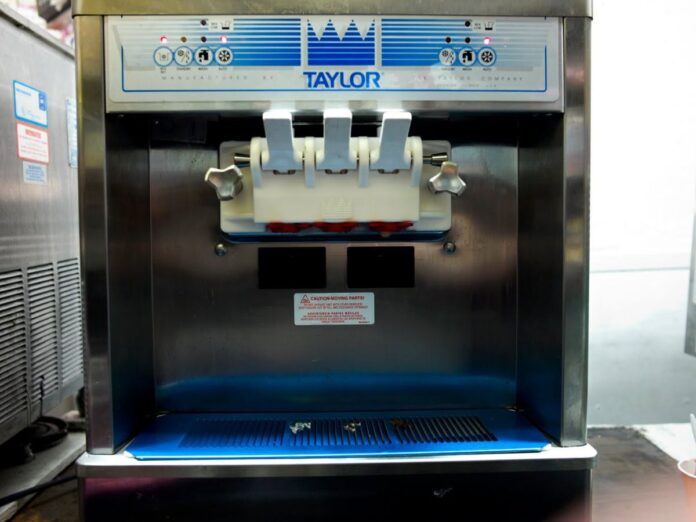Taylor machines are reliable and fast in serving ice cream, frozen yoghurt, and shakes. They must be cleaned completely and periodically to operate well and keep food safe. A clean machine keeps personnel healthy, extends tool life, and maintains product quality. We simplify the cleaning procedure into five phases and provide loads of tips to make it easier and better.
Step 1: Turn Off and Disassemble the Machine
Turning off the machine and disassembling it lets you clean all food-contact parts safely. The appropriate approach to disassembling the machine protects parts and improves cleaning. Start by turning off the machine. Unplug it from the wall to avoid accidentally turning it on while cleaning. Drain any leftover product into a clean container. Discard the product after its safe usage duration. Remove the hopper, blades, pouring tubes, seals, and O-rings to clean. See user instructions for disassembly. Handle parts carefully to avoid breaking. Remember to clean accessories like the Taylor 027503 side drip tray 11 5/8″ Length. If you can’t disassemble the machine, take images or notes. Reassembling will be easier. Check each part for damage. Broken parts should be replaced to avoid future issues.
Step 2: Rinse Components with Warm Water
Rinsing components removes product dust, making cleaning easier and more effective. Skipping this step may cause growth, making cleaning tougher. Clean each component with warm water. Too hot water can damage plastic or rubber, so avoid it. Pay attention to grooves, corners, and blade edges where the stuff sticks. Clean the surface lightly with your hands or a gentle brush. Materials that scratch or harm components should not be used. Rinse components immediately after disassembling them to avoid dust hardening. A washbasin strainer prevents O-rings from becoming misplaced.
Step 3: Wash with Food-Safe Detergent
A food-safe cleaner removes grease, germs, and other pollutants without harmful chemicals. Washing objects thoroughly prevents cross-contamination and maintains cleanliness. A food-safe cleaner should be mixed with warm water according to the instructions. Make the response safe and effective. Clean all components’ sides with a gentle brush or sponge. Pay attention to corners, edges, and cracks that collect dirt. The hopper and blades touch the product most, so pay care to them. Rinse carefully with clean water to remove any soap powder remaining after scrubbing. Only specified brushes and sponges are used to clean the Taylor machine. If you can’t remove stains or accumulation, wash it again.
Step 4: Sanitise the Components
Sanitising eliminates harmful bacteria and pathogens, making food preparation safe. Following food safety regulations requires cleanliness. Taylor machine-approved food-safe cleaning. Follow product instructions to acquire the proper amount. Add cleaned components to the sanitiser. Cover larger, non-immersible portions with a spray bottle. Hand sanitiser should be left on for the recommended few minutes. If necessary, rinse hand sanitiser with clean water. Some hand sanitisers dry without rinsing. Use gloves while using hand sanitisers to protect your skin. Wash and sanitise in separate containers to avoid contamination. Clean components should be stored in a clean environment to avoid germs.
Step 5: Reassemble and Run a Cleaning Cycle
Reassembling the equipment correctly ensures proper operation and speed. An internal cleaning cycle prepares the unit for safe usage. Before assembling, ensure all components are dry to avoid dampness issues. User instructions explain how to assemble the machine. Check that all pieces are in place. If your Taylor machine has a cleaning routine, fill the hopper with warm water and sanitiser. Clean interior components using the cycle. After cleaning, inspect the machine for issues or dust. Clean the outside using a damp cloth. Tighten seals and O-rings to prevent leaks while the machine runs. Record when to clean and how well the machine functions in a repair log.
Additional Tips for Cleaning Your Taylor Machine
Frequent cleaning maximises efficiency. Most Taylor machines must be cleaned daily, especially in high-use areas. Maintaining a schedule reduces waste and pollution. Always use Taylor-recommended or food-safe cleansers and disinfectants. Illegal products can damage machinery or leave harmful residues. Run a business? Make sure your employees know how to clean. You may prevent mistakes and work faster by following clear instructions and practising regularly. Regularly inspect blades, seals, and O-rings for wear. Replace outdated components quickly to avoid performance or contamination issues. After cleaning, store removable components in a dry area. Cleaning and preparing them for usage prevents filth. Remember to clean the machine’s outside. Wipe it down daily with a moist cloth and a little soap to remove dirt, fingerprints, and spills. Taylor provides detailed cleaning and maintenance instructions in the user handbook. Always follow these recommendations to maintain it and follow the warranty.
Conclusion:
Maintaining your Taylor machine’s cleanliness, product quality, and lifespan requires regular cleaning. Turn it off, pull it apart, rinse the parts, wash them with food-safe detergent, sanitise them, and put them back together to maintain your machine. Good daily cleaning practices will aid your business or home and ensure everyone can enjoy safe, delectable snacks. For optimum results, clean first and follow Taylor’s suggestions.
Also, read: Best Online Cake Delivery Services for Corporate Gifting








